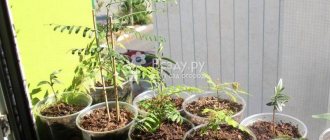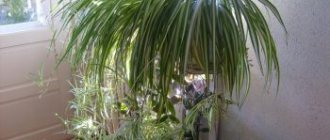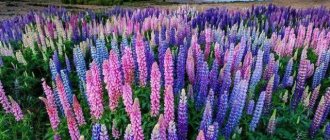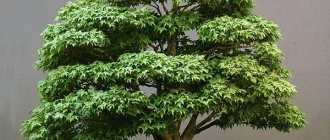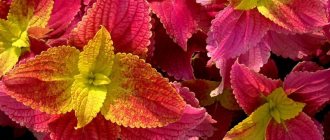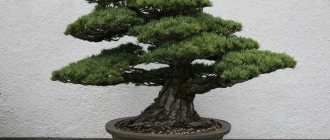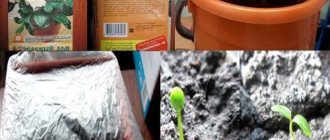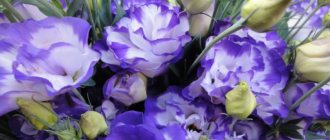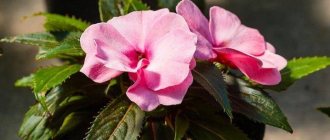You may be most familiar with Eucalyptus cinerea as the koala's favorite food. This evergreen tree can grow to 18 meters or more in height in its native Australian environment, but in home gardens it usually remains small, around 2–3 meters in height. It has reddish-brown bark that peels off on smaller branches. The leaves range in color from silver to blue-green, and when bruised they give off the plant's distinct menthol aroma. Eucalyptus trees are best planted in the spring. They grow quickly and can add up to half a meter per year. It is important to note that eucalyptus tree bark, leaves, and sap are toxic to both people and pets.
How to plant eucalyptus
When to plant
When growing eucalyptus from seed, start it indoors 10 to 12 weeks before the expected spring frost in your area. If you have a nursery plant, transplant it into the garden in the spring after the danger of frost has passed.
Choosing a landing site
Select a planting site that receives plenty of sun and has soil that drains well. Also, make sure there is enough space to accommodate the tree at its full height and width. Make sure nearby trees and shrubs do not block sunlight from the young eucalyptus. This plant can also be grown in containers as well as indoors with sufficient light.
Distance, depth and support
If you are planting several eucalyptus trees, space them at least 2.5 meters apart. Plant them at the same depth they were in the pot. These trees generally do not require stakes or other support structures to grow.
Eucalyptus care
Light
Eucalyptus loves a lot of light, so place the plant somewhere in the landscape that receives at least six hours of direct sunlight each day. Likewise, eucalyptus grown indoors should be kept near a bright window, preferably south-facing.
The soil
Eucalyptus can tolerate most soil types, but it needs soil that drains well. For container plants, use a well-draining potting mix. It is best to use soil that is slightly acidic to neutral.
Water
Once established, eucalyptus is somewhat drought tolerant. However, it really doesn't like being left dry for long periods of time, and this can cause leaves or branches to fall off. A good rule of thumb is to water when you can stick your finger into the soil and feel dryness on your fingertip. This often comes down to watering weekly if you haven't had any rain, especially for container plants.
Temperature and humidity
Eucalyptus prefers warm temperatures from 18 to 23 degrees and moderate humidity. It cannot withstand prolonged exposure to temperatures below 10 degrees. So if you are growing a plant in a container, bring it indoors if you expect cold temperatures.
Fertilizers
If you are growing the plant in the ground, it usually does not need fertilizer. However, container plants deplete their nutrients faster. So fertilize them with a low-nitrogen houseplant fertilizer throughout the growing season, following label directions.
Possible difficulties during cultivation
If maintenance conditions are violated, flower growers may face a number of problems:
- Insufficient lighting leads to excessive elongation of shoots, a decrease in the size and color of the leaves. Move the container with the plant to a lighted place or illuminate it with lamps.
- Withering and shedding of leaves is a consequence of lack of moisture; adjust watering.
- The combination of too bright sunlight and low humidity leads to burns of leaf plates.
- Excessive moisture causes stagnation of water in the soil, rotting of the roots, and softness of the foliage.
Too high temperatures in winter have a negative effect on the plant.
Raising a native of distant Australia is not so difficult; the rules of care are quite simple. A healthy plant will delight you with a lush crown of silver-green foliage, make the air cleaner, and improve your health.
Eucalyptus species
In addition to Eucalyptus ash, there are hundreds of other species of eucalyptus. These include:
- Eucalyptus globulus : Known as blue gum, this species has smooth bark and is particularly adaptable to a variety of growing conditions.
- Gunn's Eucalyptus : Commonly called cider gum, this species tolerates cold weather better than most other eucalyptus species.
- Eucalyptus platypus : Commonly called bogweed, this is a particularly hardy species that can tolerate heavy soils, cold and drought.
Eucalyptus collection
Besides its obvious beauty, eucalyptus can also be harvested for a variety of purposes. Wait until later in the growing season to harvest mature leaves and branches. If you just want leaves, simply trim them with pruning shears or by hand. Air dry them on a paper towel or drying screen in a cool place out of direct sunlight. Wait until the leaves become slightly leathery or crispy, then store them in glass jars with tightly sealed lids. Dried leaves can be used in tea and to flavor other drinks.
If you want to use branches for crafts, one of the best ways to preserve them is to use glycerin. Just trim the branch to your liking. Next, choose a container large enough to hold your entire eucalyptus branch. In a separate container, mix one part glycerin with two parts boiling water and let it cool. Pour some of the cooled liquid into a large container and then insert the cut end of a eucalyptus branch until it is about 7-10 centimeters in the liquid. Store the container in a cool, dark place and inspect the branch weekly. Add more liquid as needed to maintain it at the optimal level. It can take two to six weeks for the branch to dry. The leaves will turn from green to purple or silver and become soft and smooth. Once dry, remove the branch from the container and hang it upside down for two to three days before using it.
Beneficial features
Nowadays, eucalyptus trees are often planted artificially in order to drain swampy areas. Eucalyptus trees drink a lot of water. They are called "pumps". They can not only consume water in large quantities, but also evaporate it. A tree can evaporate about 300 liters of water. Eucalyptus wood is of very good quality and does not rot. It is used for sheathing ships and other instruments that are in direct direct contact with water. Eucalyptus leaves produce essential oil. The composition of the oil is very complex, as it contains more than forty components. In many countries, the oil is used to repel insects. Therefore, when you have to go into the forest, do not forget to take essential oil. Leaves are collected no earlier than November. Then they are dried at a temperature of 40 degrees. Different types of eucalyptus are collected separately.
How to grow eucalyptus in pots
Eucalyptus are often grown in containers outside their hardiness zone. This allows gardeners to protect their plants from the cold by bringing them indoors. However, many gardeners treat container eucalyptus plants as annuals, starting with new plants each year due to their rapid growth rate. This allows them to be used as indoor plants, as well as for use on balconies and terraces.
These plants do not like to have their roots disturbed. So it’s better to start with a large container to avoid replanting. A 20 liter container is a good size. Although unglazed clay is an ideal material for evaporating excess moisture through its walls, you may need a lighter plastic container. Just make sure any container has adequate drainage holes and use a quality, fast-draining potting mix.
Meaning
As was said a little earlier, wood is very dense, so it is used for the construction of ships, sleepers, and can also be used for making paper. It is the wood that is used to make paper. Eucalyptus trees are also used for medicinal purposes. For this, only three types of trees are used: ball, ash and twig. It is known that Spain produces liqueur, which is usually used to prevent fever.
Eucalyptus (Eucalýptus) is a genus of plants belonging to shrubs and trees that belong to the Myrtaceae . Eucalyptus is native to Australia and the island of Tasmania, but due to its numerous beneficial properties it was introduced and began to be cultivated in many countries.
Eucalyptus got its name thanks to the famous French botanist Charles Louis Léritier de Brutel, who decided to combine two Greek words: “good, good,” pronounced “eu” and “hide,” which corresponded to “calypto.” This desire, unusual at first glance, is easily explained by the plant’s ability to hide its flower buds under the cups of leaves.
Eucalyptus is capable of releasing phytoncides into the air, which kill pathogenic bacteria and viruses, fungi, its foliage contains a large amount of essential oil, which is now successfully extracted and is widely used, and eucalyptus has been planted in many countries with this problem for its ability to drain swampy areas, After all, it is capable of drawing in up to 300 liters of water in just one day! In some areas of Australia, the aborigines believed that even one drop of eucalyptus oil could protect an entire home and all the people in it from evil unclean spirits. Thanks to all this and many other beneficial properties, eucalyptus was nicknamed the “wonderful tree.”
Read also: Artificial turf paths
Eucalyptus has a very amazing ability to turn the surfaces of its leaves towards the sun with its ribs, thereby reducing the area of moisture evaporation, which is why the tree survives in hot, arid climates. This feature was also noticed by European colonists in the 18th century, who, having visited eucalyptus forests for a long time, could not understand why such huge trees did not cast an appropriate shadow. The great writer Jules Verne also wrote about this in his work “The Children of Captain Grant.”
In nature, this miracle tree can reach a height of up to a 50-story building, which is no less than 100 m in height, but at home, eucalyptus reaches only 2 m, then they try to limit its growth.
Eucalyptus propagation
Eucalyptus trees are most often grown from purchased seeds or seedlings. Trees in home gardens do not bloom often and do not produce their own seeds. They can also be propagated by cuttings, although this is not always possible. But it's an inexpensive and convenient way to get a new plant, especially since eucalyptus can be hard to find at garden centers. The best time for cuttings is when the tree is between 2 and 12 months old; rooting of mature stems is difficult.
Try to collect cuttings in late summer. Here's how:
- Prepare a small pot with three parts composted tree bark and one part perlite. Add slow-release fertilizer following label instructions for pot size. Moisten the growing medium.
- Use sterile garden shears to cut a stem about 12 centimeters long with four to eight leaves. Cut just above the leaf node.
- Remove the leaves on the bottom half of the cutting.
- Dip the cut end in rooting hormone, then plant it in growing medium almost up to the leaves.
- Keep the container in bright, indirect light in a room with a temperature of about 20 degrees. Make sure the soil remains slightly moist.
- Roots should form in about a month. At this point, you can move the new plant to a sunnier location and gradually increase the intervals between waterings. Once the weather is warm enough, move it outside for longer periods before planting it in the garden.
Features of culture
Indoor eucalyptus is a small tree with a pyramid-shaped crown. It grows very slowly; a mature crop reaches a height of one hundred and fifty centimeters. The eucalyptus houseplant is slightly smaller in size.
The foliage has an unusual green color with a blue tint. The surface of the leaf plates is glossy and shimmers in the sun. In an indoor eucalyptus in a pot, you can notice changes in foliage that occur over time.
While young leaves have a soft texture and strong aroma, mature leaves become denser and less fragrant. The buds of the plant are formed one by one, after they wither, fruits appear in the form of boxes.
The aroma comes from the presence of essential oils. They are contained in the plant in huge quantities. In addition, in room conditions, eucalyptus releases substances called phytoncides. They have an antibacterial effect, purifying the air around us. In medicine, the plant is used in the manufacture of medicines used for diseases of the respiratory system.
Agrotechnical features
Not all species can be planted at home. Indoor eucalyptus Gunny and indoor eucalyptus Lemon are suitable for this purpose. In a specialized nursery you can purchase seedlings of these varieties or grow them from seeds. The second method is long, but the seeds have good germination.
It is best to plant planting material in clay pots. They contain sand and soil in equal proportions. Seeds are sown on moist soil. The pots are placed in a prepared place with a temperature of eighteen degrees Celsius.
Watering begins on the fifth day after sowing, when the first shoots hatch. When they reach a height of three centimeters, a pick is made. Watering also begins on the fifth day. The seedlings can be placed in a permanent place in the pot after twenty days.
How to grow eucalyptus from seeds
The seeds must first be cooled in the refrigerator for two months before planting. Plant them indoors in late winter about 10 to 12 weeks before the last expected frost in your area. Use a peat potting mix that you can eventually plant directly into the soil to avoid damaging the roots. Sow the seeds on top of the growing medium, covering them only slightly. Place the pots in a warm location with indirect bright light and keep the growing medium moist but never soggy by misting. The seeds should germinate in two to three weeks. When the seedlings reach 15 centimeters in height, they are ready to go outside.
Flowering and fruiting of a eucalyptus tree
Flowering in eucalyptus trees begins from 2 to 10 years. Flowering usually occurs in late spring or early summer, but there are differences depending on the type of eucalyptus. The buds usually appear first, and then over the course of three months they begin to gradually open. They also experience fruit ripening. Ripening usually lasts one year, maybe a little longer, depending on the climate. Seeds ripen in the fruits. Seeds can be planted for ten years; they retain their viability for a very long time. There are cases when seeds are stored for forty to fifty years.
